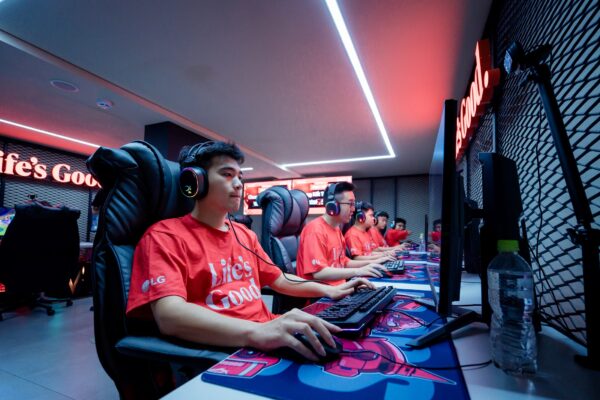The New Reality: A Deep Dive into the World of VR Gaming
For decades, video games have been windows into other worlds, viewed through the flat plane of a screen. We’ve guided heroes, built empires, and raced supercars, but always as an observer looking in. Virtual Reality (VR) gaming shatters that window. It’s a fundamental paradigm shift in interactive entertainment, trading button presses for physical actions and observation for true presence. Instead of controlling a character, you become the character. This transition from passive viewing to active participation is not just a graphical upgrade; it’s a neurological one, capable of delivering experiences with unparalleled immersion and emotional impact. The journey of VR from a niche, expensive hobby to a burgeoning mainstream platform has been fueled by technological breakthroughs, innovative game design, and a passionate gaming community. This article explores the intricate landscape of modern VR gaming, from the powerful hardware that makes it possible to the unique design principles that shape its most compelling experiences.
Section 1: The Modern VR Gaming Ecosystem
The current VR landscape is a vibrant and competitive ecosystem, primarily revolving around three distinct pillars: standalone, PC-powered, and console-based VR. Each approach offers a different balance of accessibility, power, and content, catering to a wide spectrum of players from casual users to hardcore enthusiasts. Understanding these platforms is key to navigating the world of VR Gaming.
The Platforms Defining the Market
Standalone VR: Spearheaded by Meta’s Quest line, standalone VR has been the single biggest catalyst for the technology’s mainstream adoption. These all-in-one Gaming Headsets contain their own processor, storage, and tracking systems, eliminating the need for an expensive Gaming PC or console. This “pick up and play” convenience has made VR accessible to millions. The trade-off is graphical fidelity; while impressive for a mobile chipset, it can’t match the power of dedicated Graphics Cards. However, with wireless PC streaming capabilities (Air Link), they offer a hybrid solution for those who own a capable PC.
PC VR: This is the high-fidelity frontier of VR. Systems like the Valve Index and various headsets from HTC Vive and HP Reverb connect to powerful Gaming PCs to deliver the most visually stunning and computationally complex experiences. PC VR benefits from the open ecosystem of Steam News and its SteamVR platform, which supports a vast library of games and allows for extensive customization and Game Mods. This segment is for enthusiasts who prioritize graphical quality and performance, often investing heavily in top-tier Gaming Hardware.
Console VR: Occupying a strategic middle ground, console VR offers a plug-and-play experience with higher fidelity than standalone systems. Sony has been the primary player here, with the PlayStation VR2 for the PS5. According to recent PlayStation News, the PSVR2 leverages the console’s power to deliver exclusive, high-quality AAA Games. This approach simplifies the user experience, removing the complexities of PC drivers and settings while providing a significant graphical leap over standalone hardware, making it a compelling option for the existing Console Gaming audience.
From Indie Gems to AAA Blockbusters
The VR software library has matured significantly. Initially dominated by tech demos and simple arcade experiences, it now boasts a rich catalog. AAA Games like Half-Life: Alyx and Asgard’s Wrath 2 have proven that deep, narrative-driven campaigns are not only possible but are profoundly enhanced by VR. These titles showcase breathtaking visuals and intricate physics that push the boundaries of the medium. At the same time, the Indie Games scene is a hotbed of innovation. Developers are constantly experimenting with unique mechanics, from the rhythmic slashing in Beat Saber to the tense, cooperative gameplay of tactical shooters. These indie titles often pioneer the novel interactions that define VR as a unique medium, contributing immensely to the richness of the Gaming Industry.
Section 2: The Technology Behind the Magic: A Hardware and Software Deep Dive

The magic of VR immersion is built on a foundation of sophisticated technology. Every component, from the displays in front of your eyes to the tracking sensors mapping your movement, must work in perfect harmony to trick your brain into accepting a digital world as real. Latency, resolution, and tracking accuracy are not just specs on a box; they are the pillars of presence.
Headsets and Displays: The Windows to New Worlds
The Head-Mounted Display (HMD) is the most critical piece of Gaming Hardware in a VR setup. Its quality is determined by several key metrics:
- Resolution: Measured in pixels per eye, higher resolution reduces the “screen door effect” (seeing the gaps between pixels), leading to a sharper, more realistic image. Early headsets were sub-1080p per eye, while modern HMDs like the Quest 3 and PSVR2 push beyond 2K x 2K per eye.
- Refresh Rate: This is how many times the screen updates per second, measured in Hertz (Hz). A higher refresh rate (90Hz, 120Hz, or even 144Hz on the Valve Index) results in smoother motion and is crucial for reducing motion sickness. It’s a more critical metric for comfort than what’s typically sought in standard Gaming Monitors.
- Field of View (FOV): This determines how much of the virtual world you can see at any given moment, mimicking human peripheral vision. A wider FOV (typically 110 degrees or more) enhances immersion and situational awareness, especially in fast-paced FPS Games.
- Display Technology: OLED panels offer perfect blacks and vibrant colors, enhancing contrast in dark environments (ideal for horror games), while LCD panels can achieve higher brightness and sometimes reduce persistence, leading to sharper images during fast head movements.
Tracking and Input: Achieving True Presence
Convincing immersion requires the virtual world to react perfectly to your physical movements. This is handled by tracking technology.
- Inside-Out Tracking: Cameras on the headset itself scan the environment to determine its position in 3D space. This is the standard for modern standalone and most new PC VR headsets due to its simplicity and lack of external sensors.
- Outside-In Tracking: External sensors (base stations or cameras) are placed in the room to track the headset and controllers. This method, used by the Valve Index, can offer sub-millimeter accuracy and is less prone to tracking loss when controllers are out of the headset’s camera view, making it a favorite in the Competitive Gaming scene.
Input has evolved from basic wands to sophisticated Game Controllers that track the position of individual fingers, allowing for natural grabbing and gesturing. Beyond controllers, developers are exploring innovative inputs. Some horror games, for example, use the headset’s built-in microphone, making players vulnerable if they make noise in the real world. This kind of creative input design is what makes VR uniquely immersive.
The Powerhouse Behind the Scenes: PC vs. Standalone
The performance demands of VR are immense. A system must render two separate images (one for each eye) at a high resolution and a consistently high frame rate. For PC Gaming, this requires a powerful rig, often with a high-end NVIDIA or AMD Graphics Card. Any drop below the target frame rate can cause stuttering, which immediately breaks presence and can induce nausea. Standalone headsets use highly optimized mobile processors and rely on clever rendering techniques like foveated rendering (only rendering the area the user is looking at in high detail) to achieve smooth performance.
Section 3: Designing for a New Dimension: The Art of VR Game Development
Creating a successful VR game is more than just porting a traditional Video Game into a 3D perspective. It requires a complete rethinking of Game Design principles, from how a player moves and interacts with the world to how information is presented. The most successful VR titles are those built from the ground up for the medium.
Locomotion: The Unsolved Problem?

How the player moves through the virtual world is one of the biggest challenges in VR Game Development. The disconnect between seeing movement in VR while your body remains stationary is a primary cause of motion sickness. Developers have devised several solutions:
- Teleportation: Players point to a location and instantly appear there. It’s comfortable and eliminates motion sickness but can break immersion for some.
- Smooth Locomotion: Players move using an analog stick on their controller, similar to traditional FPS Games. This offers the most freedom but is also the most likely to cause discomfort for new users. Developers often include comfort options like “vignettes” that narrow the FOV during movement.
- Room-Scale: The most immersive option, where players physically walk around their designated play space. This is limited by the size of the user’s room but provides a 1:1 sense of movement and presence.
Interaction and UI/UX in 3D Space
Traditional 2D menus and Heads-Up Displays (HUDs) feel unnatural in VR. The best practice is to use diegetic UI—integrating interface elements directly into the game world. For example, checking your ammo by physically looking at the magazine on your gun, or viewing your health on a wrist-mounted device. Physics-based interaction is another hallmark of great VR design. Instead of pressing a button to open a door, you physically reach out, grab the handle, and pull. Game engines are crucial here; recent Unreal Engine News and Unity News often highlight new tools and frameworks specifically designed to simplify the creation of these complex, physics-based VR interactions.
Pushing Boundaries: Innovative Mechanics
VR allows for mechanics impossible on a flat screen. The ability to physically duck behind cover in a shooter, manually reload a weapon under pressure, or use your hands to solve a complex 3D puzzle creates a deeper level of engagement. Some games in the Strategy Games genre allow players to loom over a battlefield like a god, manipulating units with their hands. In horror games, mechanics that track eye movement or listen for the player’s voice through a microphone create a terrifying new level of vulnerability. These VR-native mechanics are what truly separate the medium from traditional PC Gaming or Console Gaming.
Section 4: Your Gateway to Virtual Worlds: A Practical Guide

Getting started in VR can seem daunting, but with the right approach, it’s a smooth and rewarding process. Whether you’re considering your first purchase or looking to optimize your experience, here are some practical tips.
Choosing Your First Headset
- For Simplicity and Social Gaming: A standalone headset like the Meta Quest 3 is the best entry point. It’s wireless, easy to set up, and has a massive library of games and social apps.
- For High-Fidelity PC Gaming: If you already have a powerful Gaming PC, a headset like the Valve Index or a high-resolution competitor offers the ultimate visual experience. Check the required specs on Steam before buying.
- For Console Players: If you own a PlayStation 5, the PSVR2 is a no-brainer. It’s a high-quality, streamlined experience with excellent exclusive titles.
Setting Up Your Playspace
Safety is paramount. Ensure your play area is clear of furniture, pets, and other obstacles. Most systems have a “guardian” or “chaperone” feature that lets you draw a virtual boundary, which appears if you get too close to the edge. For wired headsets, consider a ceiling-mounted pulley system for cable management to avoid tripping. Good lighting is also important for headsets that use inside-out tracking.
Best Practices and Overcoming Common Hurdles
- Combatting Motion Sickness: Start with short sessions (15-20 minutes) and play stationary or teleportation-based games first. Gradually increase your playtime as you build your “VR legs.” If you feel nauseous, stop immediately. Chewing ginger gum or aiming a fan at your face can also help.
- Finding Your Community: The Gaming Community around VR is incredibly helpful. Subreddits, Discord servers, and forums are great places to find game recommendations, troubleshooting tips, and friends to play with in multiplayer titles.
- Explore Beyond Games: VR isn’t just for gaming. There are incredible fitness apps, creative tools like 3D painting software, virtual cinemas, and social platforms to explore.
Conclusion: The Future is Virtually Here
VR gaming has successfully transitioned from a futuristic concept to a tangible and rapidly evolving reality. The technology has overcome its initial hurdles of accessibility and content scarcity, establishing itself as a legitimate pillar of the Gaming Industry. We’ve moved beyond the novelty phase into an era of sophisticated hardware, deep gameplay mechanics, and unforgettable experiences that are simply not possible on any other platform. The future promises even greater advancements: lighter, more comfortable headsets with photorealistic displays, seamless integration with AR Gaming, and the potential for Cloud Gaming to stream high-fidelity VR to any device. For gamers seeking the next level of immersion, the time to step into a new reality has never been better. VR is no longer just about seeing the game; it’s about living it.













